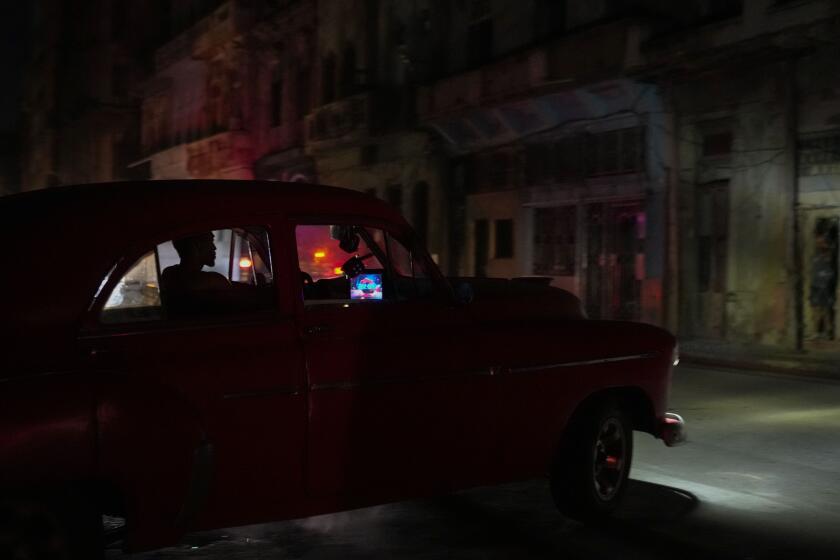Pilot Admits Removing Ancient Shell From Island
Robert R. Bredin was hiking across the rolling hills of Santa Rosa Island last spring when a shell caught his eye. He picked it up and put it in his knapsack.
On Monday, Bredin pleaded guilty in U.S. District Court in Los Angeles to removing an artifact--the shell he found the year before--from an ancient Chumash archeological site.
The 57-year-old airline pilot faces a maximum sentence of a year in federal prison and a $10,000 fine for the federal misdemeanor.
As part of a plea agreement, the government will ask that Bredin pay $3,000 in remediation to the National Park Service and a $2,500 fine and be barred from visiting any of the islands in Channel Islands National Park for the period of his probation--probably two years.
The Pacific Palisades resident is scheduled to be sentenced July 20.
The story is a bit more complicated, but it has left Bredin’s lawyers livid and caused some to question the aggressive measures the Park Service uses to investigate such incidents.
“Here’s someone who did what anyone could do, and probably a lot of people have done, and the consequences have been outrageous,” said Bredin’s attorney, Harriet Leva.
Here are the facts according to both sides: Bredin, a pilot for United Airlines, flew a private plane to Santa Rosa Island for a picnic last year with his wife and brother-in-law. He has flown frequently to many of the Channel Islands and is a friend of a family that operates a cattle ranch on Santa Rosa.
On this particular day--March 11, 1997--Bredin and his two passengers stopped for a picnic below a bluff.
After eating, Bredin and his brother-in-law poked around in the dunes.
Several park rangers spotted them through binoculars from a nearby pier and noted that the pair were in an area known to be an ancient Chumash grave site.
After lunch, Bredin and his companions hiked over to another part of the island where he found the abalone shell.
As Bredin and his companions were returning to the airstrip to fly back, they were stopped by park rangers who asked them if they had picked anything up.
Bredin opened up his knapsack and handed over the shell. The rangers then searched his companions and Bredin’s airplane. They found nothing.
Within 48 hours, a team of archeologists was flown out to the island to check the site where the picnickers had been. They found that the Chumash grave site had indeed been disturbed. The bones of a Chumash mother and an 18-month-old child were discovered, according to Assistant U.S. Atty. William W. Carter, who prosecuted the case.
Other bones--a long leg bone, and a skull--were reportedly scattered in the grass nearby.
The shell recovered from Bredin was sent to an expert at UC Santa Barbara to have it radio carbon dated. It was found to be 6,300 years old.
Less than two weeks later, on March 24, a team of six federal agents and three Los Angeles police officers arrived at Bredin’s home with a federal search warrant.
Channel Islands Park Supt. Tim Setnicka, however, said Monday that no other artifacts were found at Bredin’s home.
Agents found photos of Bredin, his wife and brother-in-law at the grave site; flight logs that recorded more than 100 trips to the Channel Islands; objects including Anasazi Indian baskets, which they say suggests an interest in Native American culture; and two rolls of undeveloped film labeled “ ’95 negatives, Santa Rosa bones,” according to Setnicka.
In Leva’s eyes, these findings prove nothing.
“The fact that this led to a full-blown search of this man’s house is an outrage,” Leva said Monday. “I think this is one of those cases where they were not investigating a crime, but an individual.”
But Setnicka maintains that Bredin’s actions were not totally innocent.
Bredin had spent a lot of time on the islands, Setnicka said, and was well-acquainted with what Native American burial and midden sites look like. Midden sites are ancient trash heaps, often filled with bones and shells, which sometimes cover earlier burial sites.
“This is not some poor individual who picks up a lonely, 6,000-year-old shell,” Setnicka said. “The former superintendent of the park knew Bredin . . . and [Bredin] clearly knew the Park Service regulations and the Park Service’s archeological resources.”
But Bredin’s lawyer disputes that.
“He thought it was a contemporary abalone shell,” Leva said. “What he did know is that the island is covered with midden sites. But he was stunned to find it was 6,000 years old.”
She also claims the subsequent investigation was heavy-handed.
“They didn’t find anything that would show he was trading in Indian artifacts,” she said. “I would imagine that is why they searched his house. And they came up totally empty-handed.”
More to Read
Sign up for Essential California
The most important California stories and recommendations in your inbox every morning.
You may occasionally receive promotional content from the Los Angeles Times.










